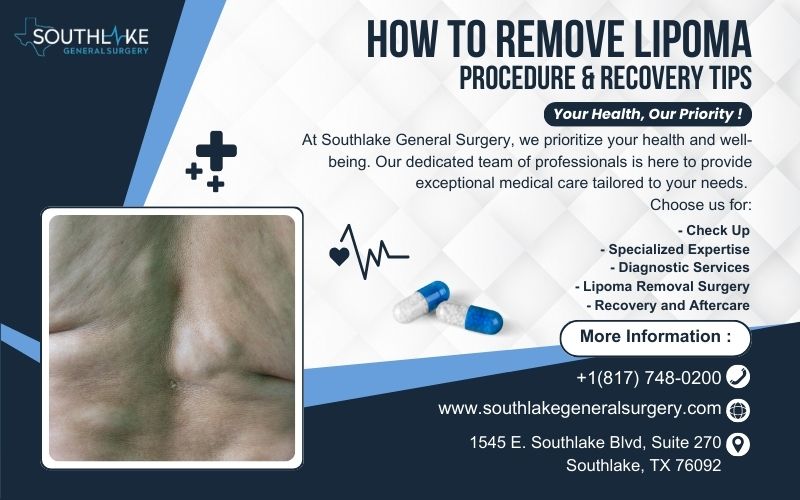To remove lipoma, a simple surgery is done. The doctor will cut off the harmless lump while you are awake and using local anesthesia. A lipoma is a fatty lump that forms just under the skin. It is not cancerous and is usually safe.
You might want to remove one if it hurts, grows fast, or looks bad. This guide will explain lipoma removal surgery, the steps involved, how to recover, and tips from expert Dr. Valeria Simone in Texas.
Key Highlights
- Lipomas are benign growths composed of fat tissue. They feel soft under the skin and grow slowly.
- Most of the time, they are safe. However, some people may want to remove a lipoma for cosmetic reasons, to feel less pain, or if it presses on nearby nerves.
- The surgery is simple and done with local anesthesia. A small cut is made to remove the lipoma, and then it is stitched up.
- Recovery is quick, and there is usually very little scarring.
- It is good to pick a skilled surgeon, like Dr. Valeria Simone, for the best results and less risk.
- Dr. Simone teaches her patients about each step, helping them from the first visit to recovery care.
Understanding Lipomas: A Brief Overview
Lipomas are soft lumps that form when fat cells in the body grow too much. These lumps are not cancerous and typically grow slowly. They usually don’t cause pain or problems and are found just under the skin. We do not fully know why lipomas happen, but they can be passed down in families.
Lipomas can show up on any part of the body. They often happen on the back, shoulders, neck, arms, and torso. Most of the time, they do not need treatment unless they cause pain, limit movement, or look bad. If that is the case, a simple surgical procedure can remove them.
What Are Lipomas?
Lipomas are fat cell lumps that are not cancerous. They grow slowly and feel soft. You can usually see them just below the skin. You can feel safe because lipomas are benign tumors and do not harm your health.
These soft tissue growths usually do not cause pain. You can feel them move a little when you press on them with your finger. We do not really know why lipomas form. Some people may be more prone to getting them due to their genes.
You can find lipomas in any area of the body with fat cells. They usually show up on the upper back, shoulders, neck, arms, and torso. Sometimes, they can grow deeper inside the body and may affect muscles or internal organs.
Common Locations and Types of Lipomas
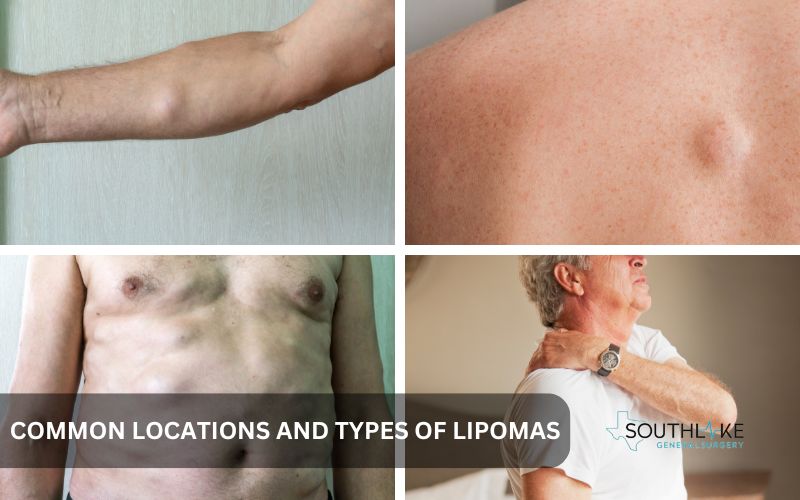
The most usual type of lipoma is called a “conventional lipoma.” It is made up only of white fat cells. These lipomas often sit in the subcutaneous fat, which is the layer of fat right under the skin.
There are several types of lipomas. Each type has its special features. For instance, angiolipomas have blood vessels inside them. Fibrolipomas are made up of fibrous tissue. Myelolipomas include parts from bone marrow.
Here’s a quick look at these variations:
- Conventional Lipoma: This type is mostly made of white fat cells and is the most common form.
- Angiolipoma: This type has fat cells and blood vessels. It can feel tender or painful.
- Fibrolipoma: This type contains both fat cells and fibrous tissue. It feels firmer when you touch it.
- Myelolipoma: This is a rare type that includes fat cells and some elements from bone marrow.
In some genetic problems, like familial multiple lipomatosis, people can get many lipomas. These lipomas can grow in large numbers in different areas of the body.
Identifying the Need for Lipoma Removal
Most lipomas are not dangerous and don’t need to be removed. You might need surgery if the lipoma hurts, grows fast, or seems concerning. If you notice any changes in the size, shape, or feel of a lipoma, please talk to a healthcare provider right away.
Several things can influence the decision to take out a lipoma. These include its size, location, any symptoms you experience, and how it affects your quality of life. Your doctor will consider all these factors and recommend the best way to move forward.
Symptoms That Indicate a Lipoma Might Need Removal
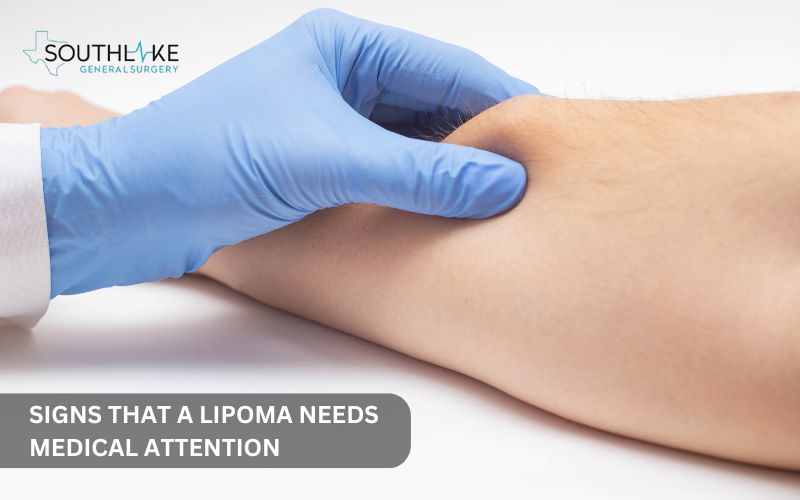
Lipomas generally do not cause any issues. However, they can feel uncomfortable sometimes. Here are a few signs that a lipoma may need to be taken out:
- Large lipomas can create bumps under the skin that aren’t appealing.
- Lipomas in spots that rub against clothes or restrict movement can feel uncomfortable and interfere with daily activities.
- When a lipoma pushes on nearby nerves, it can lead to pain, tingling, or numbness in that part of your body, impacting your quality of life.
When large lipomas hurt, look unappealing, or push on nearby nerves, it might be smart to talk to a doctor about surgery. Getting medical advice is very important. This can help you know your treatment choices and feel less anxious.
Consultation Process: When to See a Doctor

If you feel a lump on your body, visit a doctor immediately. Most lumps are harmless, but only a doctor can confirm that and check for any serious issues.
- The doctor will check the lump. He will examine it and feel its size, texture, and how it moves.
- He might suggest tests such as an ultrasound, MRI scan, or biopsy to learn more about the lump.
- This will help him make an accurate diagnosis and create a treatment plan just for you.
Healthcare providers strive to keep you healthy. They pay attention to your concerns and provide expert help.
Preparing for Lipoma Removal Surgery
Getting ready for lipoma removal surgery to remove lipoma means talking with your surgeon first. You will go over your health history and what you hope for from the surgery. The surgeon will provide special instructions just for you.
This might include things like not eating before the surgery. These steps are important to help make sure the procedure is safe and goes well.
Initial Consultation with Dr. Valeria Simone
At Southlake General Surgery in Texas, Dr. Valeria Simone is a respected expert in lipoma removal. She genuinely cares about teaching her patients and giving them personal attention. Dr. Simone wants you to fully understand the lipoma removal procedure, its benefits, and the risks involved.
- On your first visit, she will spend time going over your medical history.
- She will also give you a full physical exam to look at the size, location, and details of your lipoma.
- After looking at everything, Dr. Simone will suggest the best steps for you, focusing on less invasive options when she can.
Her commitment to personal care and her skills make Southlake General Surgery a trustworthy medical center for lipoma removal in Texas.
Pre-Surgery Guidelines and Expectations
Before your fatty lump removal procedure, your doctor will share simple steps to get ready. These will include:
- Fasting
- Medication adjustments
- Preparing the skin
It’s really important to follow these steps carefully. This helps in having a safe and successful surgery.
The removal of fatty lumps or to remove lipoma is usually done as an outpatient procedure. This way, you can go home on the same day. Doctors often use local anesthesia to keep you comfortable during surgery. If the lumps are bigger, they may recommend sedation or general anesthesia to help you feel more relaxed.
At Southlake General Surgery, we care about your comfort. We aim to make your surgery feel simple and enjoyable. Our friendly staff is ready to assist you from the time you prepare for surgery until the moment we take care of you afterward. We’re here for you every step of the way.
The Lipoma Removal Procedure
The process to remove lipoma is normally simple. It begins when the surgeon makes a small cut in the skin above the lipoma. Once they locate the lipoma, they gently take it out from the nearby tissue.
Once the surgeon removes the lipoma, he stitches up the cut. These stitches may dissolve on their own. However, some stitches need to be taken out after a week or two. This choice depends on the kind of stitches used.
Step-by-Step Surgical Process
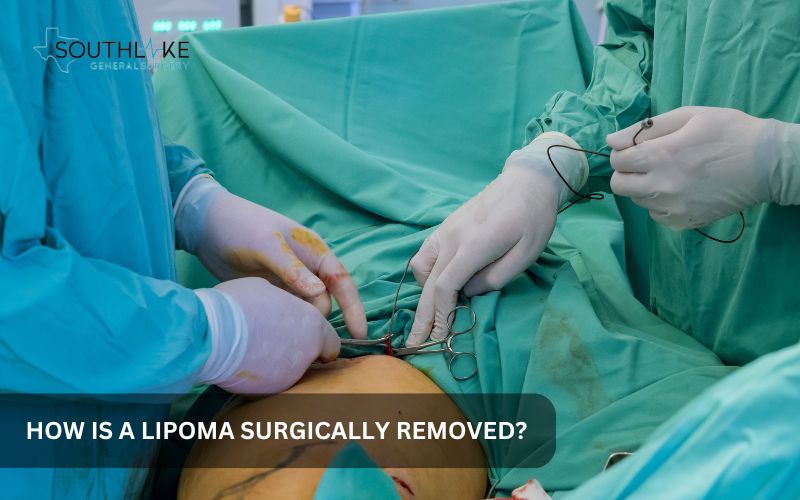
The surgery to remove a lipoma is simple. You can even go home after it. The procedure starts with a local anesthetic. This numbs the area around the lipoma, making you feel comfortable while it is done.
Once the area feels numb, the surgeon makes a small cut on the skin above the lipoma. The size of this cut depends on how big the lipoma is and its location. The surgeon aims to keep scarring to a minimum.
Through this small cut, the surgeon carefully separates the lipoma from the nearby tissues. They may use special surgical tools to gently lift and isolate the lipoma so they can remove it completely.
After the surgeon takes out the lipoma, he or she stitches up the cut. The type of stitch used depends on how big the cut is, where it is located, and what the surgeon prefers.
Techniques and Innovations in Lipoma Surgery
- Advances in surgery are changing how lipomas are taken out.
- New methods are less invasive and give better results.
- People prefer these techniques because they leave smaller scars.
- These methods also allow for quicker healing.
A 2022 study by Ramasamy K et al. introduced a new method. This method makes small cuts to lessen harm to the tissue. It is useful for several lipomas. By using this approach, there are smaller scars and quicker healing.
Liposuction is a popular way to get rid of bigger or deeper lipomas. It uses a thin tube called a cannula. The cannula goes through a small cut to remove fat. This process leaves very little scarring.
The chosen method depends on the size and place of the lipoma, along with the patient’s choice. This is usually discussed during consultations.
Recovery and Aftercare
Recovery after lipoma removal is usually fast. Most people feel only mild pain. It’s important to follow the care instructions from your surgeon carefully. This way, you can heal properly.
These instructions explain how to care for your wound. They also show you how to manage pain and what activities are safe for you. If you follow these steps and go to follow-up visits, you will heal better. This can help lower the chances of any problems.
Immediate Post-Op Care
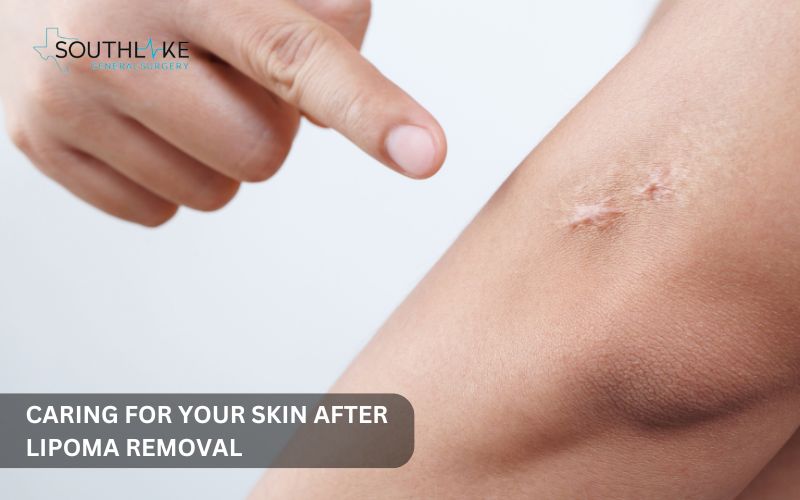
After your fatty lump is taken out, we will watch you at our clinic for a short time. This is to make sure you feel better. Before you go home, we will give you clear instructions on how to care for your incision, deal with pain, and avoid certain activities.
After the surgery, you might feel some mild pain, but normal painkillers should help. Our team will show you ways to feel comfortable while you heal. A little bruising, swelling, or mild pain around the incision is normal and will get better in a few days. However, if you feel worried or notice anything strange, please contact us right away for help.
Long-Term Recovery Tips
Long-term healing after you remove a lipoma needs a healthy lifestyle. A good lifestyle helps your body to recover. It can also reduce the chance of the lipoma returning. Although it is uncommon, eating a balanced diet, staying active, and not smoking can make your health better.
It is very important to go to check-ups with your surgeon. These visits help see how you are healing. They also help with any concerns you may have. Your surgeon will check the incision. They may remove stitches if necessary. They will also provide advice on your recovery.
Your active role in improving yourself is key for good results. If you make these lifestyle changes and stay connected with your healthcare team, you can enjoy a smooth and successful recovery for a long time.
Understanding Risks and Complications
Lipoma removal surgery carries some rare risks. These risks include infection, bleeding, reactions to anesthesia, and scarring. It’s important to understand these risks before you have surgery. If you choose an experienced surgeon like Dr. Simone, you can reduce these risks. Your safety and health should always be a priority.
Common Surgical Risks
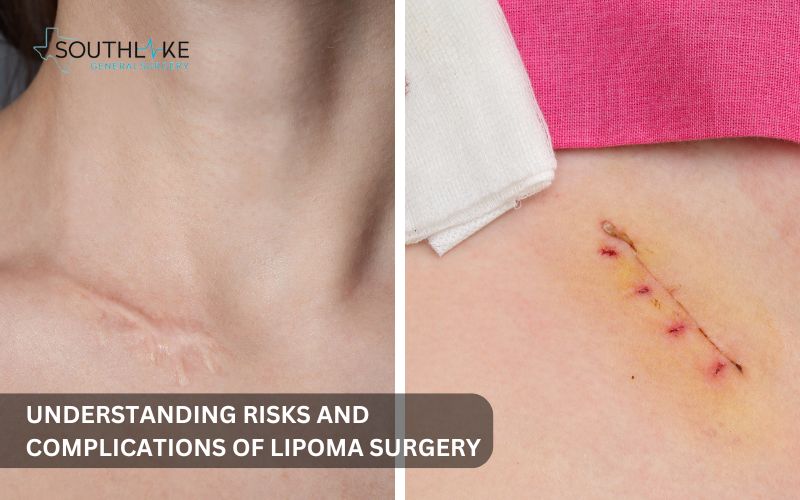
Lipoma removal is usually safe. Still, there are some rare risks to keep in mind. One risk is infection. A cut made during the procedure can let bacteria into the body. Another concern is bleeding. This can happen during or after the surgery. The bleeding can vary based on the size of the lipoma and other factors related to the patient.
Scaring is something you should think about. Doctors work to lessen scaring, but some marks might still be there. This can depend on the size and place of the incision, as well as how you heal. It’s a good idea to discuss any concerns about scarring with your doctor before the procedure.
Managing Potential Complications
Complications after lipoma removal are rare. Still, it’s important to watch for any issues. Look for unusual symptoms. These can include heavy bleeding, redness, swelling, or pus near the incision. If the pain increases and over-the-counter medicine doesn’t relieve it, contact your healthcare provider immediately.
- Get help right after surgery. This will fix problems fast and prevent them from getting worse.
- Your doctor will check what is happening and change your recovery plan if needed.
- They might give you medicine to fight infections or recommend ways to manage pain.
Your healthcare team is here to help you. It’s important to talk about any concerns you have during your recovery. This can help solve any issues fast and improve your healing process.
Conclusion
Lipoma removal procedures are safe and helpful. These procedures can reduce discomfort from painful or unattractive lipomas. Surgical methods, like excision and liposuction, can greatly improve the quality of life for people with these fatty tumors.
There are some risks and complications but discussing them with a healthcare provider who understands dermatology or surgery can help. Post-surgery, adhering to care and recovery protocols is crucial for optimal outcomes.
If you or someone you know has issues with lipomas, it is wise to seek professional medical advice. This can help you find the right treatment options. Lipoma removal can provide lasting relief and comfort.
Make an Appointment
To discuss your concerns about how to remove lipoma, you should book a meeting with Dr. Valeria Simone, MD, at Southlake General Surgery in Texas, USA. You can reach her at +1 (817) 748-0200.
Dr. Simone is an expert in lipoma removal procedures. She will provide advice based on your needs. So, don’t wait. Make an appointment today and start your journey to smooth lipoma removal.
Frequently Asked Questions
Can Lipomas Recur After Removal?
The chance of lipoma coming back after surgery is low. However, there is a small chance that these benign tumors can return. This usually occurs if some fatty tissue is left behind. It is crucial to keep in touch with your healthcare provider after lipoma is removed.
At what size should lipoma be removed?
There is no set size for when a lipoma needs to be removed. The choice to remove it depends on several things. These include if it causes discomfort if you have cosmetic reasons, or if it affects your ability to move or function. It might also rely on any risk factors present. It is essential to consult with a healthcare expert for personalized guidance that suits your specific needs.
Is it worth getting lipoma removed?
The decision on whether to proceed with lipoma surgery is contingent upon personal circumstances and preferences. If a lipoma causes pain, harms your quality of life, or affects how you feel about your appearance, removing it can make you feel better. It’s important to speak with a healthcare provider about your worries.
Is surgery the sole method for the total excision of a lipoma?
Surgery, known as excision, is the best way to get rid of lipoma. Liposuction can also be an option, but it depends on how big and where the lipoma is located. Other choices don’t involve surgery. One of these is injection lipolysis. Studies are looking into these options, but it is still unclear if they can completely remove a lipoma.
Medically Reviewed By:Dr. Valeria Simone MD
Board-certified General Surgeon at Southlake General Surgery, Texas, USA.
Follow us on Facebook and YouTube.
References:
- Guler O, Mutlu S, Mahirogulları M. Giant lipoma of the back affecting quality of life. Ann Med Surg (Lond). 2015 Aug 11;4(3):279-82. doi: 10.1016/j.amsu.2015.08.001. PMID: 26468370; PMCID: PMC4556780.
- Lee YJ, Jeong YJ, Lee JH, Jun YJ, Kim YJ. Liposarcoma in the axilla developed from a longstanding lipoma. Arch Plast Surg. 2014 Sep;41(5):600-2. doi: 10.5999/aps.2014.41.5.600. Epub 2014 Sep 15. PMID: 25276658; PMCID: PMC4179370.
- Ramasamy K, Jesudass J, Appaka CVJK, Tripathee S, Sivanesan S. Novel Technique for Obtaining Aesthetic Results in Multiple Lipomatosis Surgery. Plast Reconstr Surg Glob Open. 2022 Jul 5;10(7):e4399. doi: 10.1097/GOX.0000000000004399. PMID: 35813105; PMCID: PMC9257308.
- Xiong Y, Yang L, Zhen W, Fangyong D, Feng W, Ting L. Conservative and surgical treatment of pediatric asymptomatic lumbosacral lipoma: a meta-analysis. Neurosurg Rev. 2018 Jul;41(3):737-743. doi: 10.1007/s10143-016-0796-6. Epub 2016 Oct 28. PMID: 27796602.
- Ricci JA. Untreated for 20 Years: A 14 Kilogram Subcutaneous Lipoma. World J Plast Surg. 2018 Sep;7(3):368-371. doi: 10.29252/wjps.7.3.368.. PMID: 30560079; PMCID: PMC6290305.
- Sakamoto A, Okamoto T, Matsuda S. Subcutaneous lipomas: A minimally invasive method for resection of subcutaneous lipomas preserving retaining ligaments. Eur J Plast Surg. 2018;41(2):173-176. doi: 10.1007/s00238-017-1328-5. Epub 2017 Jun 9. PMID: 29606801; PMCID: PMC5871633.
- Kolb L, Yarrarapu SNS, Ameer MA, et al. Lipoma. [Updated 2023 Aug 8]. In: StatPearls [Internet]. Treasure Island (FL): StatPearls Publishing; 2025 Jan-. Available from: https://www.ncbi.nlm.nih.gov/books/NBK507906/
- Charifa A, Azmat CE, Badri T. Lipoma Pathology. [Updated 2022 Dec 5]. In: StatPearls [Internet]. Treasure Island (FL): StatPearls Publishing; 2025 Jan-. Available from: https://www.ncbi.nlm.nih.gov/books/NBK482343/

